Nursing Research Proposal: CRE Prevalence Comparison
VerifiedAdded on 2023/04/21
|8
|1421
|109
Report
AI Summary
This research proposal aims to conduct a surveillance culture in a hospital setting to compare the prevalence of Carbapenem-resistant Enterobacteriaceae (CRE) among patients. The study involves 50 participants, with 25 recently diagnosed with CRE and 25 with recurrent CRE. Stool samples will be collected, and carbapenem-producing Enterobacteriaceae (CPE) cultures will be performed. Bacterial isolates will be identified using methods like MALDI-TOF and mass spectroscopy, followed by screening using MHT and CIT tests to detect carbapenemase enzymes. The research expects higher prevalence of carbapenemase-producing Enterobacteriaceae in recurrent CRE patients. The proposal also discusses organizational culture, expected outcomes, methodology, potential barriers such as workload and lack of administrative support, and the impact of the research on improving patient care and professional expertise. The study is designed to run for 14 days and includes a detailed literature review with relevant references.

Running head: RESEARCH PROPOSAL
Nursing
Name of the student:
Name of the university:
Author note:
Nursing
Name of the student:
Name of the university:
Author note:
Paraphrase This Document
Need a fresh take? Get an instant paraphrase of this document with our AI Paraphraser
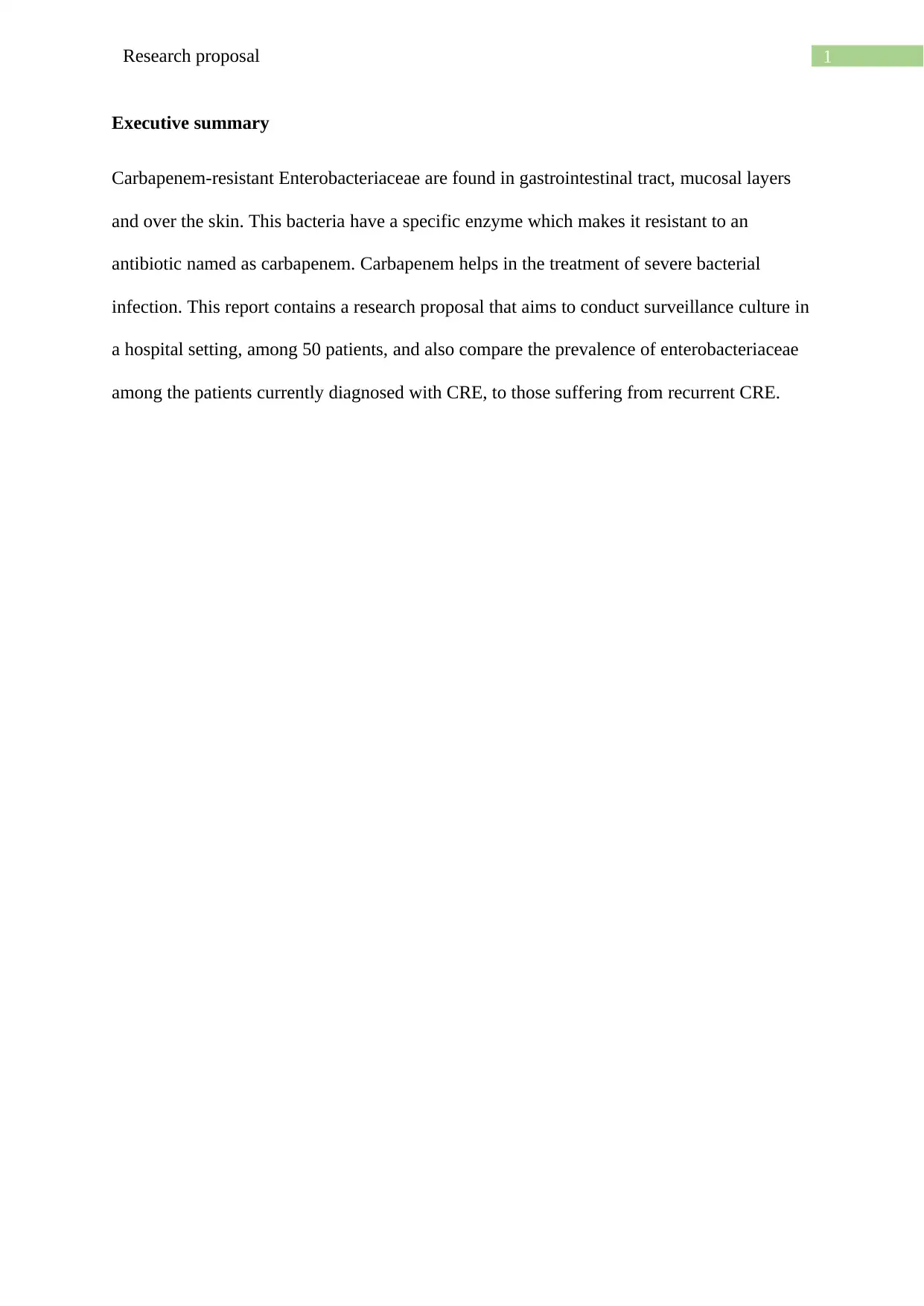
1Research proposal
Executive summary
Carbapenem-resistant Enterobacteriaceae are found in gastrointestinal tract, mucosal layers
and over the skin. This bacteria have a specific enzyme which makes it resistant to an
antibiotic named as carbapenem. Carbapenem helps in the treatment of severe bacterial
infection. This report contains a research proposal that aims to conduct surveillance culture in
a hospital setting, among 50 patients, and also compare the prevalence of enterobacteriaceae
among the patients currently diagnosed with CRE, to those suffering from recurrent CRE.
Executive summary
Carbapenem-resistant Enterobacteriaceae are found in gastrointestinal tract, mucosal layers
and over the skin. This bacteria have a specific enzyme which makes it resistant to an
antibiotic named as carbapenem. Carbapenem helps in the treatment of severe bacterial
infection. This report contains a research proposal that aims to conduct surveillance culture in
a hospital setting, among 50 patients, and also compare the prevalence of enterobacteriaceae
among the patients currently diagnosed with CRE, to those suffering from recurrent CRE.
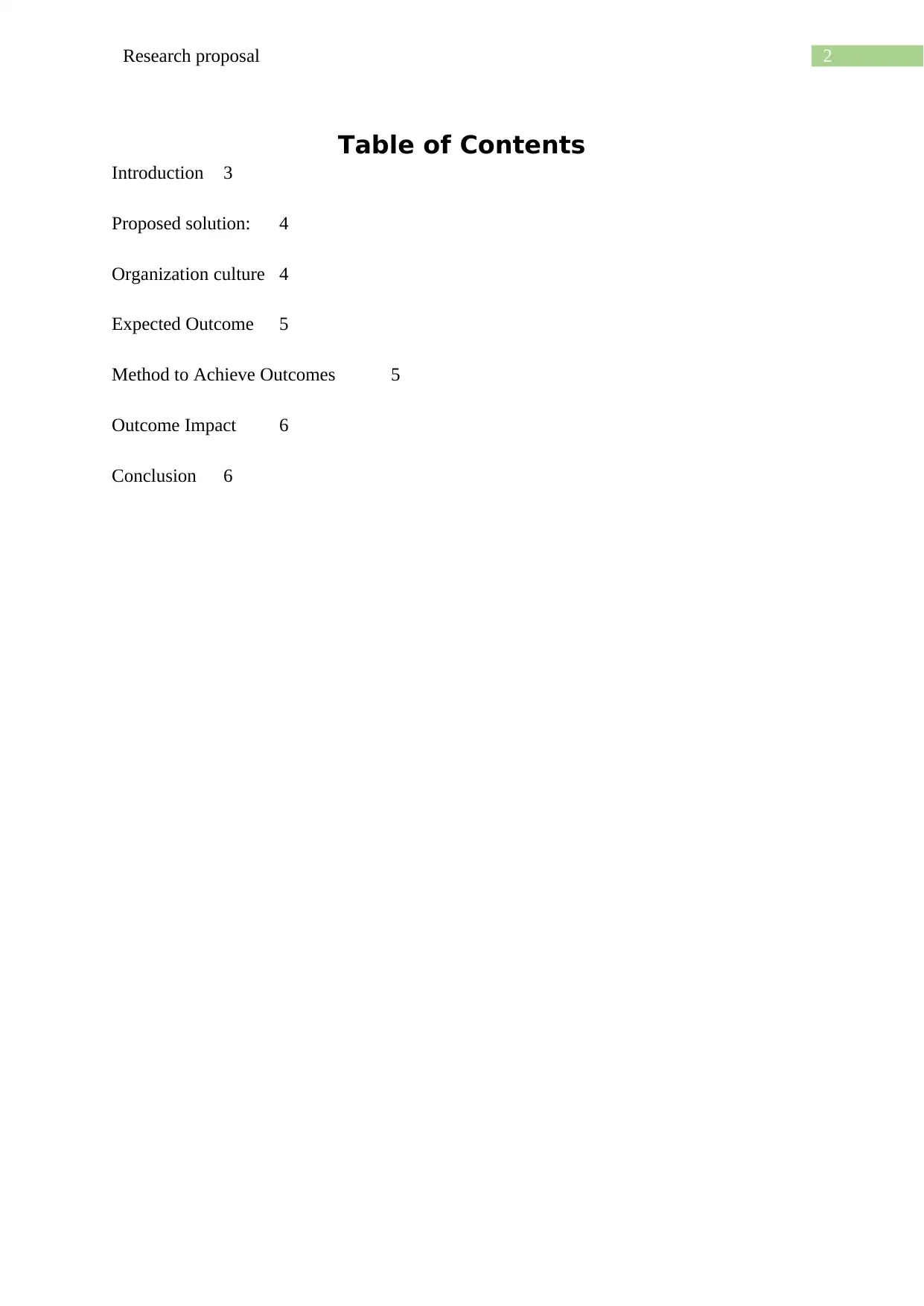
2Research proposal
Table of Contents
Introduction 3
Proposed solution: 4
Organization culture 4
Expected Outcome 5
Method to Achieve Outcomes 5
Outcome Impact 6
Conclusion 6
Table of Contents
Introduction 3
Proposed solution: 4
Organization culture 4
Expected Outcome 5
Method to Achieve Outcomes 5
Outcome Impact 6
Conclusion 6
⊘ This is a preview!⊘
Do you want full access?
Subscribe today to unlock all pages.

Trusted by 1+ million students worldwide
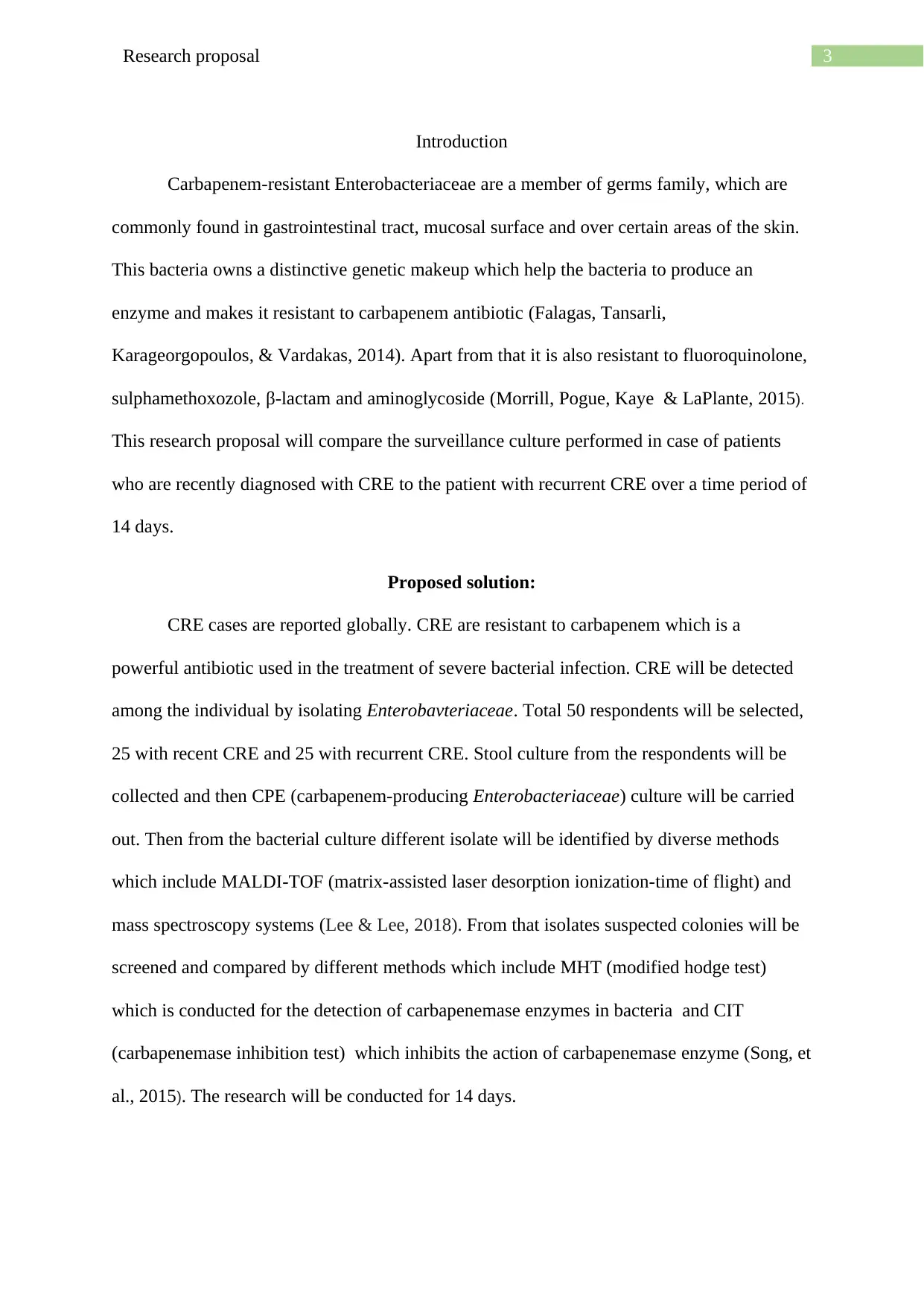
3Research proposal
Introduction
Carbapenem-resistant Enterobacteriaceae are a member of germs family, which are
commonly found in gastrointestinal tract, mucosal surface and over certain areas of the skin.
This bacteria owns a distinctive genetic makeup which help the bacteria to produce an
enzyme and makes it resistant to carbapenem antibiotic (Falagas, Tansarli,
Karageorgopoulos, & Vardakas, 2014). Apart from that it is also resistant to fluoroquinolone,
sulphamethoxozole, β-lactam and aminoglycoside (Morrill, Pogue, Kaye & LaPlante, 2015).
This research proposal will compare the surveillance culture performed in case of patients
who are recently diagnosed with CRE to the patient with recurrent CRE over a time period of
14 days.
Proposed solution:
CRE cases are reported globally. CRE are resistant to carbapenem which is a
powerful antibiotic used in the treatment of severe bacterial infection. CRE will be detected
among the individual by isolating Enterobavteriaceae. Total 50 respondents will be selected,
25 with recent CRE and 25 with recurrent CRE. Stool culture from the respondents will be
collected and then CPE (carbapenem-producing Enterobacteriaceae) culture will be carried
out. Then from the bacterial culture different isolate will be identified by diverse methods
which include MALDI-TOF (matrix-assisted laser desorption ionization-time of flight) and
mass spectroscopy systems (Lee & Lee, 2018). From that isolates suspected colonies will be
screened and compared by different methods which include MHT (modified hodge test)
which is conducted for the detection of carbapenemase enzymes in bacteria and CIT
(carbapenemase inhibition test) which inhibits the action of carbapenemase enzyme (Song, et
al., 2015). The research will be conducted for 14 days.
Introduction
Carbapenem-resistant Enterobacteriaceae are a member of germs family, which are
commonly found in gastrointestinal tract, mucosal surface and over certain areas of the skin.
This bacteria owns a distinctive genetic makeup which help the bacteria to produce an
enzyme and makes it resistant to carbapenem antibiotic (Falagas, Tansarli,
Karageorgopoulos, & Vardakas, 2014). Apart from that it is also resistant to fluoroquinolone,
sulphamethoxozole, β-lactam and aminoglycoside (Morrill, Pogue, Kaye & LaPlante, 2015).
This research proposal will compare the surveillance culture performed in case of patients
who are recently diagnosed with CRE to the patient with recurrent CRE over a time period of
14 days.
Proposed solution:
CRE cases are reported globally. CRE are resistant to carbapenem which is a
powerful antibiotic used in the treatment of severe bacterial infection. CRE will be detected
among the individual by isolating Enterobavteriaceae. Total 50 respondents will be selected,
25 with recent CRE and 25 with recurrent CRE. Stool culture from the respondents will be
collected and then CPE (carbapenem-producing Enterobacteriaceae) culture will be carried
out. Then from the bacterial culture different isolate will be identified by diverse methods
which include MALDI-TOF (matrix-assisted laser desorption ionization-time of flight) and
mass spectroscopy systems (Lee & Lee, 2018). From that isolates suspected colonies will be
screened and compared by different methods which include MHT (modified hodge test)
which is conducted for the detection of carbapenemase enzymes in bacteria and CIT
(carbapenemase inhibition test) which inhibits the action of carbapenemase enzyme (Song, et
al., 2015). The research will be conducted for 14 days.
Paraphrase This Document
Need a fresh take? Get an instant paraphrase of this document with our AI Paraphraser
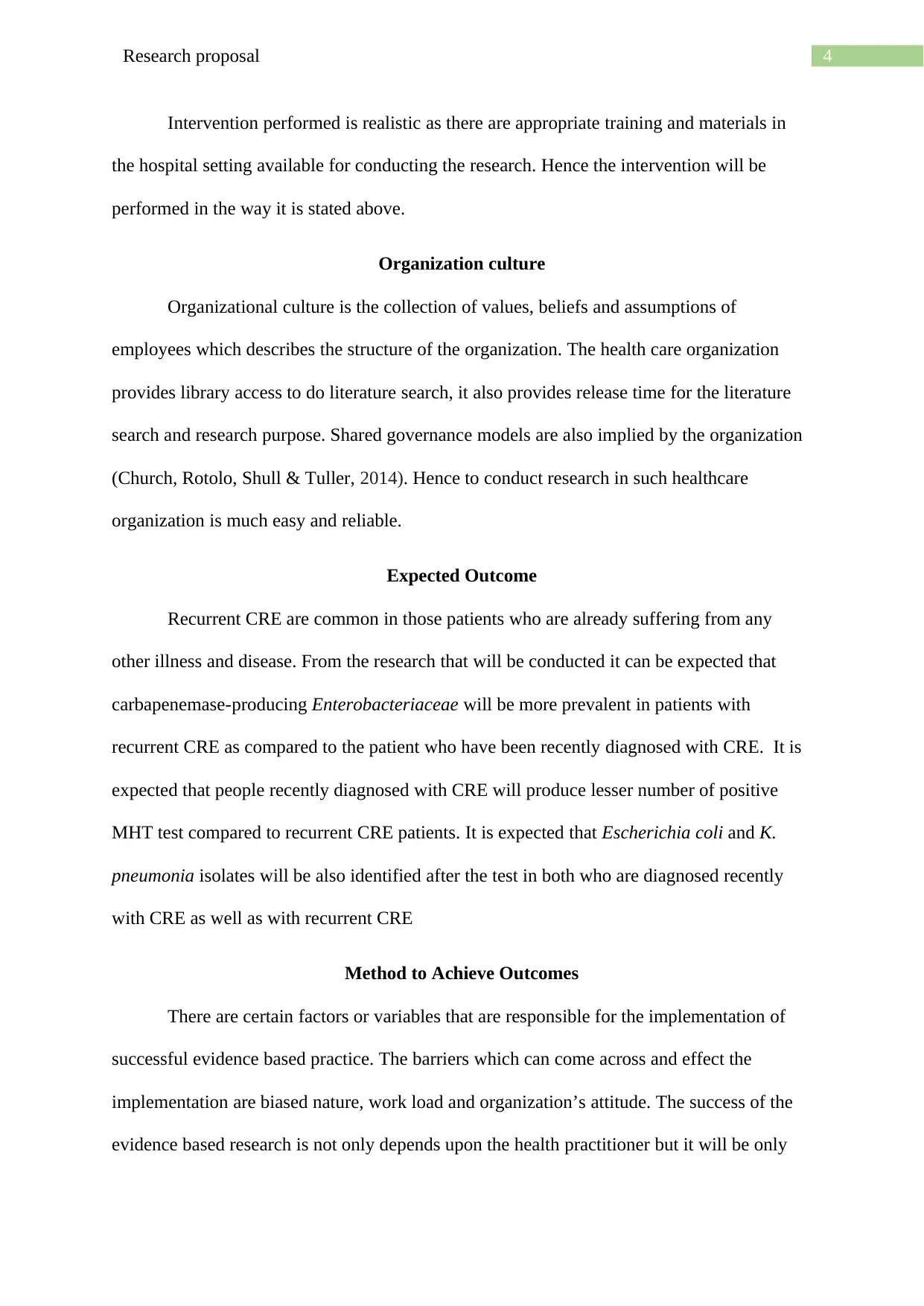
4Research proposal
Intervention performed is realistic as there are appropriate training and materials in
the hospital setting available for conducting the research. Hence the intervention will be
performed in the way it is stated above.
Organization culture
Organizational culture is the collection of values, beliefs and assumptions of
employees which describes the structure of the organization. The health care organization
provides library access to do literature search, it also provides release time for the literature
search and research purpose. Shared governance models are also implied by the organization
(Church, Rotolo, Shull & Tuller, 2014). Hence to conduct research in such healthcare
organization is much easy and reliable.
Expected Outcome
Recurrent CRE are common in those patients who are already suffering from any
other illness and disease. From the research that will be conducted it can be expected that
carbapenemase-producing Enterobacteriaceae will be more prevalent in patients with
recurrent CRE as compared to the patient who have been recently diagnosed with CRE. It is
expected that people recently diagnosed with CRE will produce lesser number of positive
MHT test compared to recurrent CRE patients. It is expected that Escherichia coli and K.
pneumonia isolates will be also identified after the test in both who are diagnosed recently
with CRE as well as with recurrent CRE
Method to Achieve Outcomes
There are certain factors or variables that are responsible for the implementation of
successful evidence based practice. The barriers which can come across and effect the
implementation are biased nature, work load and organization’s attitude. The success of the
evidence based research is not only depends upon the health practitioner but it will be only
Intervention performed is realistic as there are appropriate training and materials in
the hospital setting available for conducting the research. Hence the intervention will be
performed in the way it is stated above.
Organization culture
Organizational culture is the collection of values, beliefs and assumptions of
employees which describes the structure of the organization. The health care organization
provides library access to do literature search, it also provides release time for the literature
search and research purpose. Shared governance models are also implied by the organization
(Church, Rotolo, Shull & Tuller, 2014). Hence to conduct research in such healthcare
organization is much easy and reliable.
Expected Outcome
Recurrent CRE are common in those patients who are already suffering from any
other illness and disease. From the research that will be conducted it can be expected that
carbapenemase-producing Enterobacteriaceae will be more prevalent in patients with
recurrent CRE as compared to the patient who have been recently diagnosed with CRE. It is
expected that people recently diagnosed with CRE will produce lesser number of positive
MHT test compared to recurrent CRE patients. It is expected that Escherichia coli and K.
pneumonia isolates will be also identified after the test in both who are diagnosed recently
with CRE as well as with recurrent CRE
Method to Achieve Outcomes
There are certain factors or variables that are responsible for the implementation of
successful evidence based practice. The barriers which can come across and effect the
implementation are biased nature, work load and organization’s attitude. The success of the
evidence based research is not only depends upon the health practitioner but it will be only
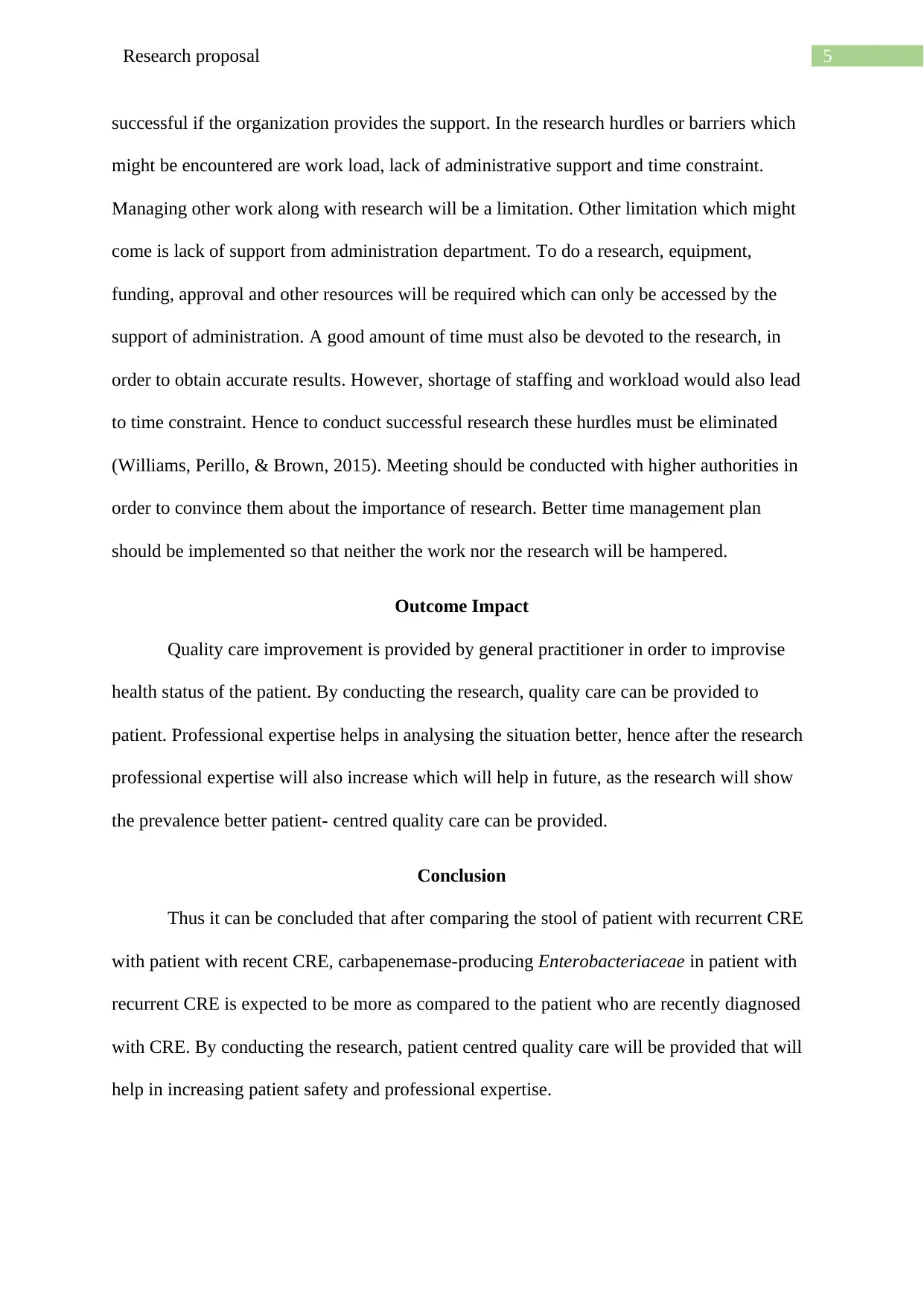
5Research proposal
successful if the organization provides the support. In the research hurdles or barriers which
might be encountered are work load, lack of administrative support and time constraint.
Managing other work along with research will be a limitation. Other limitation which might
come is lack of support from administration department. To do a research, equipment,
funding, approval and other resources will be required which can only be accessed by the
support of administration. A good amount of time must also be devoted to the research, in
order to obtain accurate results. However, shortage of staffing and workload would also lead
to time constraint. Hence to conduct successful research these hurdles must be eliminated
(Williams, Perillo, & Brown, 2015). Meeting should be conducted with higher authorities in
order to convince them about the importance of research. Better time management plan
should be implemented so that neither the work nor the research will be hampered.
Outcome Impact
Quality care improvement is provided by general practitioner in order to improvise
health status of the patient. By conducting the research, quality care can be provided to
patient. Professional expertise helps in analysing the situation better, hence after the research
professional expertise will also increase which will help in future, as the research will show
the prevalence better patient- centred quality care can be provided.
Conclusion
Thus it can be concluded that after comparing the stool of patient with recurrent CRE
with patient with recent CRE, carbapenemase-producing Enterobacteriaceae in patient with
recurrent CRE is expected to be more as compared to the patient who are recently diagnosed
with CRE. By conducting the research, patient centred quality care will be provided that will
help in increasing patient safety and professional expertise.
successful if the organization provides the support. In the research hurdles or barriers which
might be encountered are work load, lack of administrative support and time constraint.
Managing other work along with research will be a limitation. Other limitation which might
come is lack of support from administration department. To do a research, equipment,
funding, approval and other resources will be required which can only be accessed by the
support of administration. A good amount of time must also be devoted to the research, in
order to obtain accurate results. However, shortage of staffing and workload would also lead
to time constraint. Hence to conduct successful research these hurdles must be eliminated
(Williams, Perillo, & Brown, 2015). Meeting should be conducted with higher authorities in
order to convince them about the importance of research. Better time management plan
should be implemented so that neither the work nor the research will be hampered.
Outcome Impact
Quality care improvement is provided by general practitioner in order to improvise
health status of the patient. By conducting the research, quality care can be provided to
patient. Professional expertise helps in analysing the situation better, hence after the research
professional expertise will also increase which will help in future, as the research will show
the prevalence better patient- centred quality care can be provided.
Conclusion
Thus it can be concluded that after comparing the stool of patient with recurrent CRE
with patient with recent CRE, carbapenemase-producing Enterobacteriaceae in patient with
recurrent CRE is expected to be more as compared to the patient who are recently diagnosed
with CRE. By conducting the research, patient centred quality care will be provided that will
help in increasing patient safety and professional expertise.
⊘ This is a preview!⊘
Do you want full access?
Subscribe today to unlock all pages.

Trusted by 1+ million students worldwide
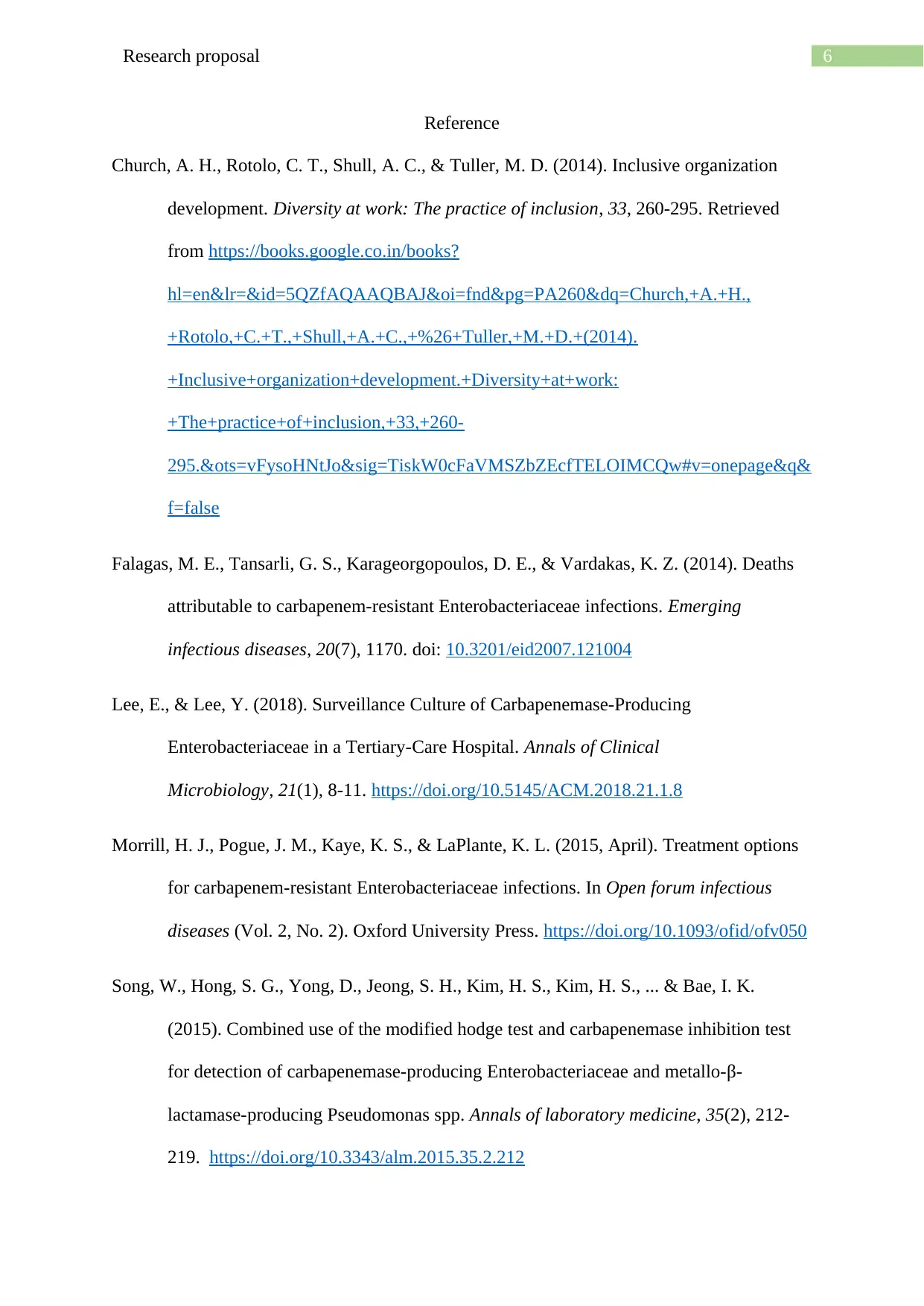
6Research proposal
Reference
Church, A. H., Rotolo, C. T., Shull, A. C., & Tuller, M. D. (2014). Inclusive organization
development. Diversity at work: The practice of inclusion, 33, 260-295. Retrieved
from https://books.google.co.in/books?
hl=en&lr=&id=5QZfAQAAQBAJ&oi=fnd&pg=PA260&dq=Church,+A.+H.,
+Rotolo,+C.+T.,+Shull,+A.+C.,+%26+Tuller,+M.+D.+(2014).
+Inclusive+organization+development.+Diversity+at+work:
+The+practice+of+inclusion,+33,+260-
295.&ots=vFysoHNtJo&sig=TiskW0cFaVMSZbZEcfTELOIMCQw#v=onepage&q&
f=false
Falagas, M. E., Tansarli, G. S., Karageorgopoulos, D. E., & Vardakas, K. Z. (2014). Deaths
attributable to carbapenem-resistant Enterobacteriaceae infections. Emerging
infectious diseases, 20(7), 1170. doi: 10.3201/eid2007.121004
Lee, E., & Lee, Y. (2018). Surveillance Culture of Carbapenemase-Producing
Enterobacteriaceae in a Tertiary-Care Hospital. Annals of Clinical
Microbiology, 21(1), 8-11. https://doi.org/10.5145/ACM.2018.21.1.8
Morrill, H. J., Pogue, J. M., Kaye, K. S., & LaPlante, K. L. (2015, April). Treatment options
for carbapenem-resistant Enterobacteriaceae infections. In Open forum infectious
diseases (Vol. 2, No. 2). Oxford University Press. https://doi.org/10.1093/ofid/ofv050
Song, W., Hong, S. G., Yong, D., Jeong, S. H., Kim, H. S., Kim, H. S., ... & Bae, I. K.
(2015). Combined use of the modified hodge test and carbapenemase inhibition test
for detection of carbapenemase-producing Enterobacteriaceae and metallo-β-
lactamase-producing Pseudomonas spp. Annals of laboratory medicine, 35(2), 212-
219. https://doi.org/10.3343/alm.2015.35.2.212
Reference
Church, A. H., Rotolo, C. T., Shull, A. C., & Tuller, M. D. (2014). Inclusive organization
development. Diversity at work: The practice of inclusion, 33, 260-295. Retrieved
from https://books.google.co.in/books?
hl=en&lr=&id=5QZfAQAAQBAJ&oi=fnd&pg=PA260&dq=Church,+A.+H.,
+Rotolo,+C.+T.,+Shull,+A.+C.,+%26+Tuller,+M.+D.+(2014).
+Inclusive+organization+development.+Diversity+at+work:
+The+practice+of+inclusion,+33,+260-
295.&ots=vFysoHNtJo&sig=TiskW0cFaVMSZbZEcfTELOIMCQw#v=onepage&q&
f=false
Falagas, M. E., Tansarli, G. S., Karageorgopoulos, D. E., & Vardakas, K. Z. (2014). Deaths
attributable to carbapenem-resistant Enterobacteriaceae infections. Emerging
infectious diseases, 20(7), 1170. doi: 10.3201/eid2007.121004
Lee, E., & Lee, Y. (2018). Surveillance Culture of Carbapenemase-Producing
Enterobacteriaceae in a Tertiary-Care Hospital. Annals of Clinical
Microbiology, 21(1), 8-11. https://doi.org/10.5145/ACM.2018.21.1.8
Morrill, H. J., Pogue, J. M., Kaye, K. S., & LaPlante, K. L. (2015, April). Treatment options
for carbapenem-resistant Enterobacteriaceae infections. In Open forum infectious
diseases (Vol. 2, No. 2). Oxford University Press. https://doi.org/10.1093/ofid/ofv050
Song, W., Hong, S. G., Yong, D., Jeong, S. H., Kim, H. S., Kim, H. S., ... & Bae, I. K.
(2015). Combined use of the modified hodge test and carbapenemase inhibition test
for detection of carbapenemase-producing Enterobacteriaceae and metallo-β-
lactamase-producing Pseudomonas spp. Annals of laboratory medicine, 35(2), 212-
219. https://doi.org/10.3343/alm.2015.35.2.212
Paraphrase This Document
Need a fresh take? Get an instant paraphrase of this document with our AI Paraphraser

7Research proposal
Williams, B., Perillo, S., & Brown, T. (2015). What are the factors of organisational culture
in health care settings that act as barriers to the implementation of evidence-based
practice? A scoping review. Nurse education today, 35(2), e34-e41.
https://doi.org/10.1016/j.nedt.2014.11.012
Williams, B., Perillo, S., & Brown, T. (2015). What are the factors of organisational culture
in health care settings that act as barriers to the implementation of evidence-based
practice? A scoping review. Nurse education today, 35(2), e34-e41.
https://doi.org/10.1016/j.nedt.2014.11.012
1 out of 8
Related Documents
Your All-in-One AI-Powered Toolkit for Academic Success.
+13062052269
info@desklib.com
Available 24*7 on WhatsApp / Email
![[object Object]](/_next/static/media/star-bottom.7253800d.svg)
Unlock your academic potential
Copyright © 2020–2025 A2Z Services. All Rights Reserved. Developed and managed by ZUCOL.





